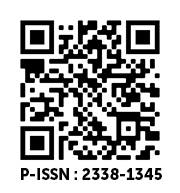Assessment of cattle welfare on Ghanaian farms
DOI:
https://doi.org/10.36782/apjsafe.v9i2.113Keywords:
Animal Welfare, Cattle, Farmers, Ghana, StockmanshipAbstract
The objective of the study was to assess farm welfare conditions and the observance of welfare by cattle farmers in Ghana. The study applied field approaches to gather and analyze data. Data was collected from farms in the Northern, North East and Savanna regions. A total of three hundred and eighteen (318) cattle farmers were interviewed using semi-structured questionnaire. Observations and focus group discussions were also used to obtain data or verify some of the responses from the cattle farmers. Data collected was classified and summarized on the basis of the information provided. The study found evidence that most farmers were concerned about their animal’s welfare, but did not place equal weight on the five freedoms of animal welfare. Farmers placed the most premium on freedom from hunger, malnutrition and thirst (95%), and freedom from pain, injury and disease (90%). Farmers placed less premium on their animals freedoms from fear and distress (50%), and freedom from physical and thermal discomfort (50%). The freedom to express normal patterns of behaviour (0%) was not considered by the farmers. Observance of animal welfare by cattle farms was relatively below acceptable standards and government interventions are needed to improve animal welfare in Ghana.
Downloads
References
Allen, L. R. (2014). Wild dog control impacts on calf wastage in extensive beef cattle enterprises. Animal Production Science, 54(2), 214. https://doi.org/10.1071/AN12356
Broom, D. M. (1991). Animal welfare: concepts and measurement. In Journal of animal science (Vol. 69, Issue 10, pp. 4167–4175). J Anim Sci. https://doi.org/10.2527/1991.69104167x
Broom, Donald M. (2011). A History of Animal Welfare Science. In Acta Biotheoretica (Vol. 59, Issue 2, pp. 121–137). https://doi.org/10.1007/s10441-011-9123-3
Chebel, R. C., Silva, P. R. B., Endres, M. I., Ballou, M. A., and Luchterhand, K. L. (2016). Social stressors and their effects on immunity and health of periparturient dairy cows1. Journal of Dairy Science, 99(4), 3217–3228. https://doi.org/10.3168/jds.2015-10369
Claude, M. (2009). Food And Agriculture Organization Of The United Nations Food Insecurity and Vulnerability Information and Mapping Systems Nutrition Country Profile Republic Of Ghana. https://www.moh.gov.gh/wp-content/uploads/2016/02/Nutrition-Country-Profile-Ghana.pdf
Denning, S. S., Washburn, S. P., and Watson, D. W. (2014). Development of a novel walk-through fly trap for the control of horn flies and other pests on pastured dairy cows. Journal of Dairy Science, 97(7), 4624–4631. https://doi.org/10.3168/jds.2013-7872
Dessie, T., and Okeyo Mwai, A. (2019). The story of cattle in Africa: Why diversity matters. ILRI, Rural Development Administration, Republic of Korea and AU-IBAR. https://cgspace.cgiar.org/handle/10568/108945
Forkman, B., Boissy, A., Meunier-Salaün, M. C., Canali, E., and Jones, R. B. (2007). A critical review of fear tests used on cattle, pigs, sheep, poultry and horses. Physiology and Behavior, 92(3), 340–374. https://doi.org/10.1016/j.physbeh.2007.03.016
Gebregeziabhear, E., and Ameha, N. (2015). The Effect of Stress on Productivity of Animals:A Review. 5(3). www.iiste.org
Grandin, T., and Shivley, C. (2015). How farm animals react and perceive stressful situations such as handling, restraint, and transport. In Animals (Vol. 5, Issue 4, pp. 1233–1251). MDPI AG. https://doi.org/10.3390/ani5040409
GSS. (2021). Ghana Statistical Service. September, 1–7. www.census2021.statsghana.gh
Hammond, A. C., Olson, T. A., Chase, C. C., Bowers, E. J., Randel, R. D., Murphy, C. N., Vogt, D. W., and Tewolde, A. (1996). Heat tolerance in two tropically adapted Bos taurus breeds, Senepol and Romosinuano, compared with Brahman, Angus, and Hereford cattle in Florida. Journal of Animal Science, 74(2), 295. https://doi.org/10.2527/1996.742295x
Hewson, C. J. (2003). What is animal welfare? Common definitions and their practical consequences. In The Canadian Veterinary Journal (Vol. 44, Issue 6, pp. 496–499). http://www.scopus.com/inward/record.url?eid=2-s2.0-0038016423andpartnerID=40andmd5=3e7642782f751d5061f5608394924dd4
Katiyatiya, C. L. F., Muchenje, V., and Mushunje, A. (2014). Farmers’ perceptions and knowledge of cattle adaptation to heat stress and tick resistance in the Eastern Cape, South Africa. Asian-Australasian Journal of Animal Sciences, 27(11), 1663–1670. https://doi.org/10.5713/ajas.2014.14174
Kim, J., Hanotte, O., Mwai, O. A., Dessie, T., Bashir, S., Diallo, B., Agaba, M., Kim, K., Kwak, W., Sung, S., Seo, M., Jeong, H., Kwon, T., Taye, M., Song, K.-D., Lim, D., Cho, S., Lee, H.-J., Yoon, D., … Kim, H. (2017). The genome landscape of indigenous African cattle. Genome Biology 2017 18:1, 18(1), 1–14. https://doi.org/10.1186/S13059-017-1153-Y
Komwihangilo, D. M., Lekule, F. P., Kajembe, G. C., and Petersen, P. H. (2007). Role of Local Knowledge in Mixed Livestock Production Systems. Outlook on Agriculture, 36(3), 187–192. https://doi.org/10.5367/000000007781891513
Kumi-Boateng, B., and Ziggah, Y. Y. (2020). A 3D Procrustean Approach to Transform WGS84 Coordinates to Ghana War Office 1926 Reference Datum. Ghana Mining Journal, 20(1), 1–10. https://doi.org/10.4314/gm.v20i1.1
Li, R., Li, C., Chen, H., Li, R., Chong, Q., Xiao, H., and Chen, S. (2020). Genome-wide scan of selection signatures in Dehong humped cattle for heat tolerance and disease resistance. Animal Genetics, 51(2), 292–299. https://doi.org/10.1111/age.12896
Lindahl, C., Pinzke, S., Herlin, A., and Keeling, L. J. (2016). Human-animal interactions and safety during dairy cattle handling-Comparing moving cows to milking and hoof trimming. Journal of Dairy Science, 99(3), 2131–2141. https://doi.org/10.3168/jds.2014-9210
Misra, K. K., and Kumar, K. A. (2004). Ethno-veterinary Practices Among the Konda Reddi of East Godavari District of Andhra Pradesh. Studies of Tribes and Tribals, 2(1), 37–44. https://doi.org/10.1080/0972639x.2004.11886502
Mockshell, J., Ilukor, J., and Birner, R. (2014). Providing animal health services to the poor in Northern Ghana: Rethinking the role of community animal health workers? Tropical Animal Health and Production, 46(2), 475–480. https://doi.org/10.1007/s11250-013-0518-9
Mushtaq, S., Shah, A. M., Shah, A., Lone, S. A., Hussain, A., Hassan, Q. P., and Ali, M. N. (2018). Bovine mastitis: An appraisal of its alternative herbal cure. In Microbial Pathogenesis (Vol. 114, pp. 357–361). Academic Press. https://doi.org/10.1016/j.micpath.2017.12.024
Naiga, R., Penker, M., and Hogl, K. (2015). Challenging pathways to safe water access in rural Uganda: From supply to demand-driven water governance. International Journal of the Commons, 9(1), 237–260. https://doi.org/10.18352/ijc.480
Nuvey, F. S., Kreppel, K., Nortey, P. A., Addo-Lartey, A., Sarfo, B., Fokou, G., Ameme, D. K., Kenu, E., Sackey, S., Addo, K. K., Afari, E., Chibanda, D., and Bonfoh, B. (2020). Poor mental health of livestock farmers in Africa: A mixed methods case study from Ghana. BMC Public Health, 20(1), 825. https://doi.org/10.1186/s12889-020-08949-2
OIE World Organization for Animal Health. (2017). Animal welfare strategy in africa (awsa) final version.
Parkes, P. (1987). Livestock symbolism and pastoral ideology among the Kafirs of the Hindu Kush. Man, 22(4), 637–660. https://doi.org/10.2307/2803356
Parthiban, R., Vijayakumar, S., Prabhu, S., and Morvin Yabesh, J. G. E. (2016). Quantitative traditional knowledge of medicinal plants used to treat livestock diseases from Kudavasal taluk of Thiruvarur District, Tamil Nadu, India. Revista Brasileira de Farmacognosia, 26(1), 109–121. https://doi.org/10.1016/j.bjp.2015.07.016
Roessler, R., Mpouam, S. E., Muchemwa, T., and Schlecht, E. (2016). Emerging development pathways of urban livestock production in rapidly growing West Africa cities. Sustainability (Switzerland), 8(11). https://doi.org/10.3390/su8111199
Rushen, J., and Passillé, A. M. de. (2017). The importance of good stockmanship and its benefits to animals. Improving animal welfare: a practical approach (pp. 125–138). CABI. https://doi.org/10.1079/9781780644677.0125
Scholtz, M. M., McManus, C., Okeyo, A. M., and Theunissen, A. (2011). Opportunities for beef production in developing countries of the southern hemisphere. Livestock Science, 142(1–3), 195–202. https://doi.org/10.1016/j.livsci.2011.07.014
Sher, H., and Alyemeni, M. N. (2011). Pharmaceutically important plants used in traditional system of arab medicine for the treatment of livestock ailments in the Kingdom of Saudi Arabia. African Journal of Biotechnology, 10(45), 9153–9159. https://doi.org/10.5897/ajb10.1570
Smith, O. B., Olaloku, E. A., Smith’, O. B., and Olaloku2, E. A. (1998). Peri-urban livestock production systems in sub-saharan africa cities feeding people series report 24 peri-urban livestock production systems in sub-saharan africa.
Taylor, N., and Fraser, H. (2019). The Cow Project: Analytical and Representational Dilemmas of Dairy Farmers’ Conceptions of Cruelty and Kindness. Animal Studies Journal, 8(2), 133–153. https://doi.org/10.14453/asj.v8i2.10
Terrestrial Code: OIE - World Organisation for Animal Health. (n.d.). Retrieved December 8, 2020, from https://www.oie.int/standard-setting/terrestrial-code/
Traoré, L., Yaro, V. S. O., Soudré, A., Ouédraogo-Koné, S., Ouédraogo, D., Yougbaré, B., Zoma, B. L., Hien, M., Guissou, M. L., Traoré, A., Mészáros, G., Wurzinger, M., Burger, P., Okeyo, A. M., Thiombiano, A., and Sölkner, J. (2020). Indigenous knowledge of veterinary medicinal plant use in cattle treatment in southwestern Burkina Faso (West Africa). South African Journal of Botany, 128, 189–199. https://doi.org/10.1016/j.sajb.2019.09.015
Van Laer, E., Moons, C. P. H., Ampe, B., Sonck, B., Vandaele, L., De Campeneere, S., and Tuyttens, F. A. M. (2015). Effect of summer conditions and shade on behavioural indicators of thermal discomfort in Holstein dairy and Belgian Blue beef cattle on pasture. https://doi.org/10.1017/S1751731115000804
Veasey, J. S. (2017). In pursuit of peak animal welfare; the need to prioritize the meaningful over the measurable. Zoo Biology, 36(6), 413–425. https://doi.org/10.1002/zoo.21390
Wallach, A. D., Ramp, D., and O’Neill, A. J. (2017). Cattle mortality on a predator-friendly station in central Australia. Journal of Mammalogy, 98(1), 45–52. https://doi.org/10.1093/jmammal/gyw156
Wanzala, W., Zessin, K. H., Kyule, N. M., Baumann, M. P. O., Mathia, E., and Hassanali, A. (2005). Ethnoveterinary medicine: a critical review of its evolution, perception, understanding and the way forward. http://localhost:8080/xmlui/handle/123456789/6887
Water Resources and Livestock: An increasing constraint. (2021). Retrieved March 19, 2021, from http://www-naweb.iaea.org/na/news-na/na-water-resources-livestock.html
Woods, A. (2012). From cruelty to welfare: The emergence of farm animal welfare in Britain, 1964-71. In Endeavour (Vol. 36, Issue 1, pp. 14–22). Elsevier Current Trends. https://doi.org/10.1016/j.endeavour.2011.10.003
Zulkifli, I. (2013). Review of human-animal interactions and their impact on animal productivity and welfare. Journal of Animal Science and Biotechnology 2013 4:1, 4(1), 1–7. https://doi.org/10.1186/2049-1891-4-25









